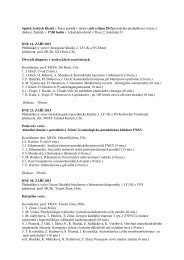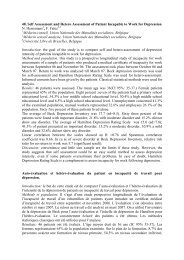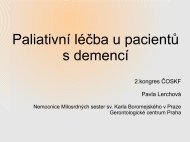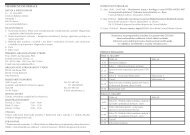ABSTRACTS â ORAL PRESENTATIONS - AMCA, spol. s r.o.
ABSTRACTS â ORAL PRESENTATIONS - AMCA, spol. s r.o.
ABSTRACTS â ORAL PRESENTATIONS - AMCA, spol. s r.o.
You also want an ePaper? Increase the reach of your titles
YUMPU automatically turns print PDFs into web optimized ePapers that Google loves.
Acetylation of histones, along with other epigenetic modifications, has been described<br />
as the main epigenetic regulator controlling cell fate and therefore histone deacetylase<br />
inhibitors (HDIs) are being investigated as a new promising group of anticancer drugs<br />
(De Ruijter et al., 2003). HDIs induce hyperacetylation of proteins/histones, thus<br />
decondensing chromatine structure, which subsequently increases the accessibility of<br />
DNA to transcription factors and activates specific genes, tumor suppressor, oncogenes<br />
and non-histones proteins implicated in differentiation, proliferation, cell cycle and<br />
apoptosis. Moreover, HDIs may enhance, through processes described above, cytotoxicity<br />
of drugs targeting DNA. HDIs are of both natural and synthetic origin and they have<br />
demonstrated potent anticancer activity in many pre-clinical and clinical trials, either<br />
as monotherapies or in combination with conventional chemotherapy (Glaser, 2007).<br />
These include derivates of hydroxamic acid: suberoylanilid hydroxamic acid (Vorinostat,<br />
SAHA - treatment of cutaneous T cell lymphoma) and trichostatin A (TSA - antifungal<br />
antibiotic); and a group of short-chain fatty acids HDIs: valproic acid (VPA - epilepsy drug)<br />
and sodium phenylbutyrate (NaPB – disorders of the urea cycle).<br />
Remodeling of chromatin structure may contribute to enhanced sensitivity to<br />
photochemical and photobiological processes caused by PDT, increasing the ability of<br />
oxygen radicals to attack DNA thus influence cell differentiation and cell death. The aim<br />
of this study was therefore to evaluate the impact of HDIs alone and in combination with<br />
hypericin-mediated photodynamic therapy (HY-PDT) on the response of a human HT-29<br />
colon adenocarcinoma cell line.<br />
Based on extensive screening using the MTT assay, one hypericin and two concentrations<br />
for each HDI were chosen for further experiments. Analysis of total cell number<br />
demonstrated that pre-treatment with all HDIs alone and HY-PDT reduced the total cell<br />
number significantly. A more pronounced drop in this parameter was observed when<br />
combined treatment of HDIs with HY-PDT was applied. The impact of HDIs and of HY-PDT<br />
was further characterized using flow cytometry. Lower concentrations of TSA significantly<br />
decreased mitochondrial membrane potential (MMP) in comparison to other HDIs. Pretreatment<br />
with higher concentrations of SAHA and TSA made cells more vulnerable to<br />
damage resulting from HY-PDT and this led to a considerable dissipation of the MMP. A<br />
similar pattern of the effect on MMP between the two groups of HDIs was also observed.<br />
Subsequently, we analysed the effect of HDIs, HY-PDT and their combination on the<br />
viability/metabolic activity of cancer cells. Similarly to MMP, we observed a higher<br />
potential of the hydroxamic acid derivates (SAHA, TSA) to sensitize cancer cells to the<br />
effect of HY-PDT. We detected a significantly higher number of dead cells in combined<br />
treatment than when drugs were applied alone at both time intervals. The analysis of<br />
cell cycle distribution revealed an accumulation of cells in the S phase after treatment<br />
with higher concentrations of SAHA, TSA and VPA in combination with HY-PDT.<br />
In this study we observed that HDIs are able to modulate and enhance the cytotoxic effects<br />
of HY-PDT. However, the details of molecular mechanisms mediating photodynamicsensitization<br />
by HDIs are at present, not elucidated.<br />
Acknowledgements<br />
This work was supported by the Slovak Research and Development Agency under<br />
contract no. APVV-0040-10 and VVCE-0001-07 and the Scientific Grant Agency of the<br />
Ministry of Education of the Slovak Republic under contract No. VEGA 1/0626/11.<br />
102 Analytical Cytometry VII








